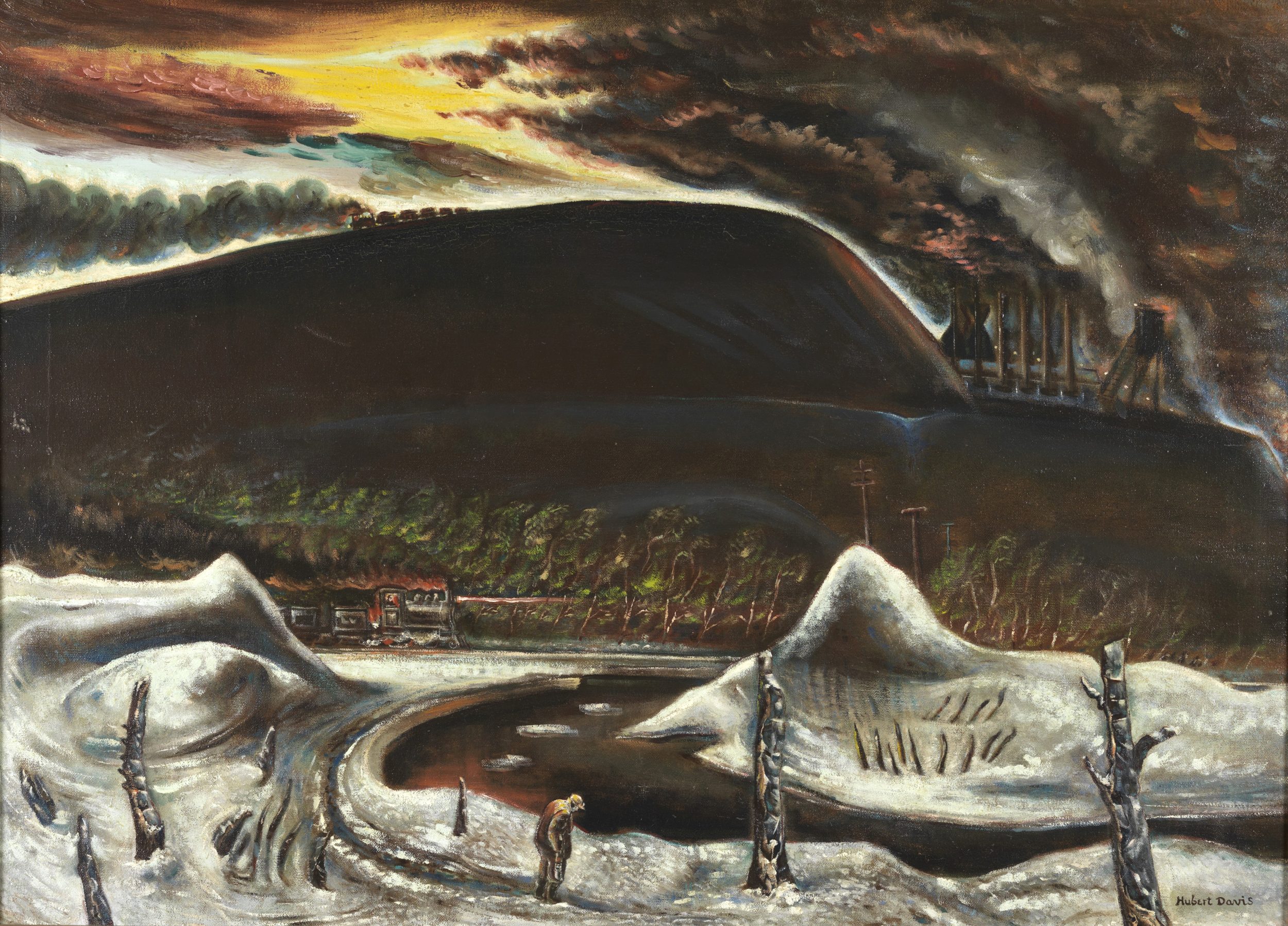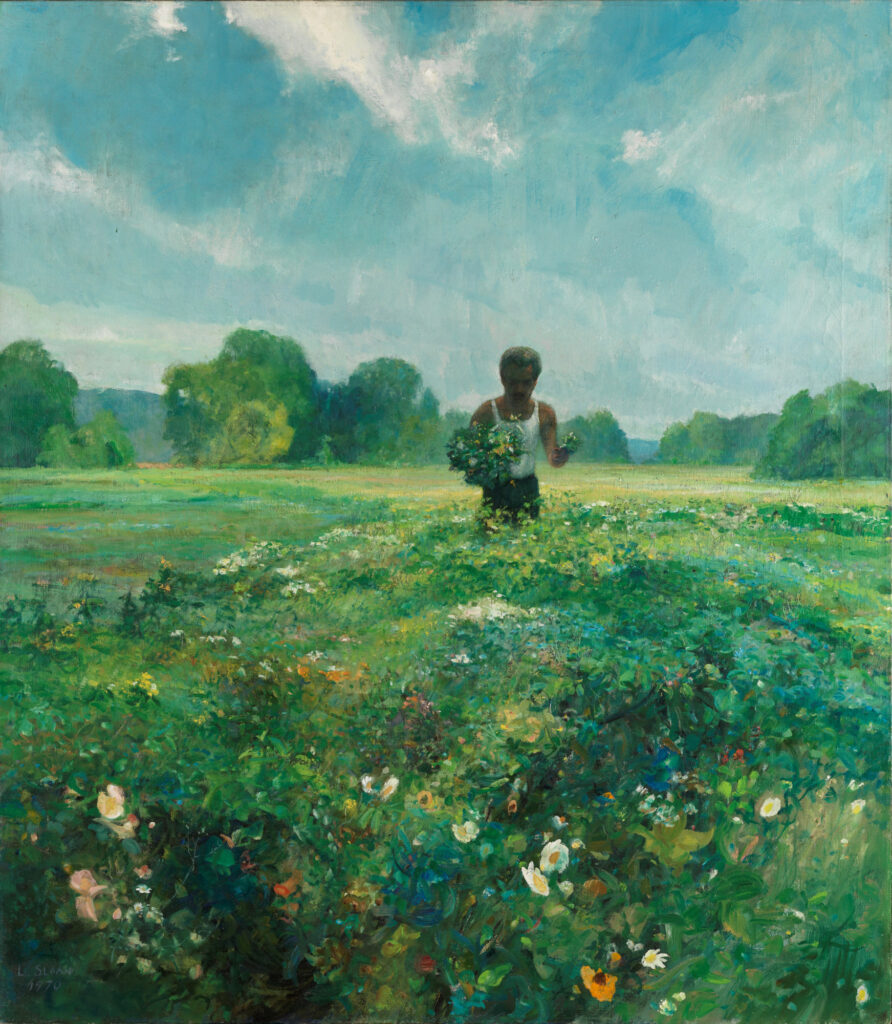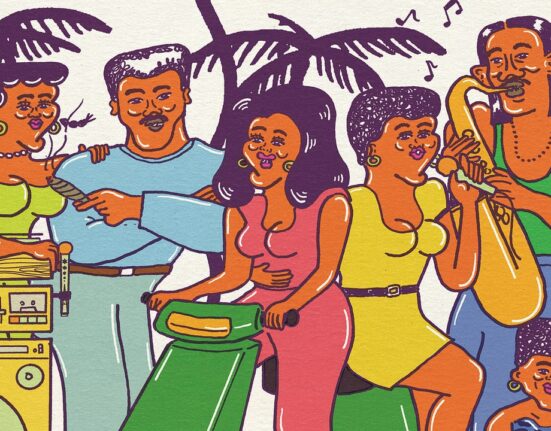In a 2018 photograph taken by the Philadelphia artist Andrea Walls, a ghost floats toward the viewer. Draped in a white shroud and framed by power lines and splintered tree branches, the faceless figure is following train tracks that fall off the edge of the page.
Walls’ eerie portrait, called “Railroaded,” appears in the final section of a new exhibit about Appalachian art now at the Pennsylvania Academy of the Fine Arts in Philadelphia. Placed alongside paintings of coal miners and graying manufacturing towns, its presence in “Layers of Liberty: Philadelphia and the Appalachian Environment” suggests something haunted about the city’s connections to Appalachia, which includes 70 percent of Pennsylvania, stretching from the northeastern corner of the state to Pittsburgh and the western border.
Curated by West Virginia native Ali Printz, an artist and curatorial fellow at the academy, the exhibit illustrates the ties between Philadelphia and the natural resource extraction—of Appalachian timber, coal, oil and gas—that fueled its growth for centuries. In Walls’ work, those ties are literal, the march of wooden slats visible beneath the phantom’s feet. They are also historical: In the 19th century, railroads made it possible to transport coal faster and farther, driving the expansion of mining in Appalachian Pennsylvania and making Philadelphia a manufacturing hub so mighty that it was known as “The Workshop of the World.”
“Philadelphia was built on the back of Appalachian labor and resources,” Printz said in a recent interview. “Philadelphia would not exist at the capacity that it was and is if it weren’t for the coal that was mined and the riches that were made from that.”
With this exhibit, Printz draws attention to that history of environmental abuse and its relationship to the silencing of Appalachian voices. “There’s a very close tie between this systemic erasure of positive contributions of Appalachia to American culture and outsider interests coming in for coal and timber and gas and all of the resources that they took from the region,” she said. That pattern of degradation and exploitation continues in the 21st century. For Americans who live outside Appalachia, “it’s kind of out of sight, out of mind, but for the people that are living in the region, it’s like a constant battle.”
“Layers of Liberty” begins with pastoral depictions of a Pennsylvania wilderness untouched by industrialization. In these 19th-century images of sunsets and towering trees, European settlers and their descendants confront an awe-inspiring landscape. But as Printz points out, that landscape was already under assault and had been since colonization began. Deforestation was well under way, and the rivers were being used to move coal toward the coast.


In an etching from 1884 by Catherine Dallett, “On the Lehigh Canal,” an important route for transporting anthracite coal from the mining centers of Northeastern Pennsylvania to Philadelphia and other cities, Dallett depicts the canal as a bucolic scene, where the water is still, and a man and his horses walking on the bank seem to exist only to give a sense of scale. Printz writes that Dallett and artists like her deliberately left the true scope of industrial activity out of their work, an omission that amounts to romanticization.
Dallett’s etching appears in a section of the exhibit called “The Machine in the Garden,” a trope that refers to the jarring intrusion of modern technology and commerce into nature. In a 1964 book of the same name, the literary critic and historian Leo Marx explains why this theme became pervasive in culture as the industrial revolution roared to life in the United States.
“Within the lifetime of a single generation, a rustic and in large part wild landscape was transformed into the site of the world’s most productive industrial machine,” he wrote. “It would be difficult to imagine more profound contradictions of value or meaning than those made manifest by this circumstance.”
That transformation was carried out in the mountains and valleys of Appalachia at astonishing speed, leaving behind enduring scars.
This story is funded by readers like you.
Our nonprofit newsroom provides award-winning climate coverage free of charge and advertising. We rely on donations from readers like you to keep going. Please donate now to support our work.
The final section of the exhibit, called “More Than Land or Sky,” showcases the impacts of the region on Philadelphia’s artists and art institutions. Fred Danziger, whose painting “The Quarry” is featured in the exhibit and who was trained at the Pennsylvania academy, grew up in Pittsburgh and remembers seeing the legacy of extraction in western Pennsylvania as a child.
“The contrast between strip mines and the natural landscape was a real impactful thing in my youth growing up,” Danziger said. He remembers a nearby creek turned orange and lifeless by mines’ acid runoff. “That always struck me as something that was a failure of our species,” he said.
The creek was cleaned up beginning in the 1970s, he said, and people fish and swim there now. But across Pennsylvania, abandoned mines still create water pollution, subsidence, underground fires and the venting of hazardous gases.
“Appalachia is such a part of our heritage,” Danziger said. While it might seem unexpected for Philadelphia to host this exhibit rather than a city like Pittsburgh, “maybe it’s more important that it be in places other than Appalachia,” he said.
Printz hopes to curate exhibits that focus on Appalachian art for other museums. “I think that it’s something that can operate as a uniting force for people,” she said, connecting ongoing drilling, logging and fracking in the region to the climate crisis. “What’s happening in Appalachia is a microcosm for what’s happening nationally and globally.”


![“Untitled [Figure with oil barrels],” mid 20th century by Dox Thrash. Credit: Courtesy of the Pennsylvania Academy of the Fine Arts. Gift of Dr. Constance E. Clayton in loving memory of her mother Mrs. Williabell Clayton, 2019.3.60](https://galleryrevieweurope.com/wp-content/uploads/2024/07/1721728489_572_For-Appalachian-Artists-the-Landscape-Is-Much-More-Than-the.jpg)
![“Untitled [Figure with oil barrels],” mid 20th century by Dox Thrash. Credit: Courtesy of the Pennsylvania Academy of the Fine Arts. Gift of Dr. Constance E. Clayton in loving memory of her mother Mrs. Williabell Clayton, 2019.3.60](https://galleryrevieweurope.com/wp-content/uploads/2024/07/1721728489_572_For-Appalachian-Artists-the-Landscape-Is-Much-More-Than-the.jpg)
Ultimately, “Layers of Liberty” is a study in contradictions, setting coal miners’ misery (like Philip Evergood’s “Mine Disaster,” meant to “make martyrs” of miners who toiled and sometimes died in the dark) beside the sublime beauty of the Appalachian landscape. Two watercolors by Hobson Lafayette Pittman from 1929 hanging next to each other illustrate this contrast in miniature: one a cheerful depiction of a village surrounded by trees and fields, the other a gritty townscape of warehouses, railroad tracks and smoke.
“It was impossible to not include the narratives of extraction. It was really important for me to show them,” Printz said. But she didn’t want those narratives to define the exhibit as they have outsiders’ understanding of Appalachia in the past and present, caricatures that have been used to flatten and exploit the land and its people. “I wanted to show that there’s other works being made about Appalachia that don’t necessarily deal with coal and extraction. They deal with the beauty of the region and the rich history of the region.”
One of the last works in the exhibit is “Self-Portrait in Landscape” by the African American artist Louis Sloan, a large painting from 1970 that portrays its subject alone in a vast and sun-drenched meadow, wispy clouds overhead. He is at ease in a waist-high sea of wildflowers, a newly-plucked bouquet in his hand. The grasses behind him reach toward blue hills and the horizon, a solitary vision of joy in nature that is much more than land, sky or stereotype.
About This Story
Perhaps you noticed: This story, like all the news we publish, is free to read. That’s because Inside Climate News is a 501c3 nonprofit organization. We do not charge a subscription fee, lock our news behind a paywall, or clutter our website with ads. We make our news on climate and the environment freely available to you and anyone who wants it.
That’s not all. We also share our news for free with scores of other media organizations around the country. Many of them can’t afford to do environmental journalism of their own. We’ve built bureaus from coast to coast to report local stories, collaborate with local newsrooms and co-publish articles so that this vital work is shared as widely as possible.
Two of us launched ICN in 2007. Six years later we earned a Pulitzer Prize for National Reporting, and now we run the oldest and largest dedicated climate newsroom in the nation. We tell the story in all its complexity. We hold polluters accountable. We expose environmental injustice. We debunk misinformation. We scrutinize solutions and inspire action.
Donations from readers like you fund every aspect of what we do. If you don’t already, will you support our ongoing work, our reporting on the biggest crisis facing our planet, and help us reach even more readers in more places?
Please take a moment to make a tax-deductible donation. Every one of them makes a difference.
Thank you,









